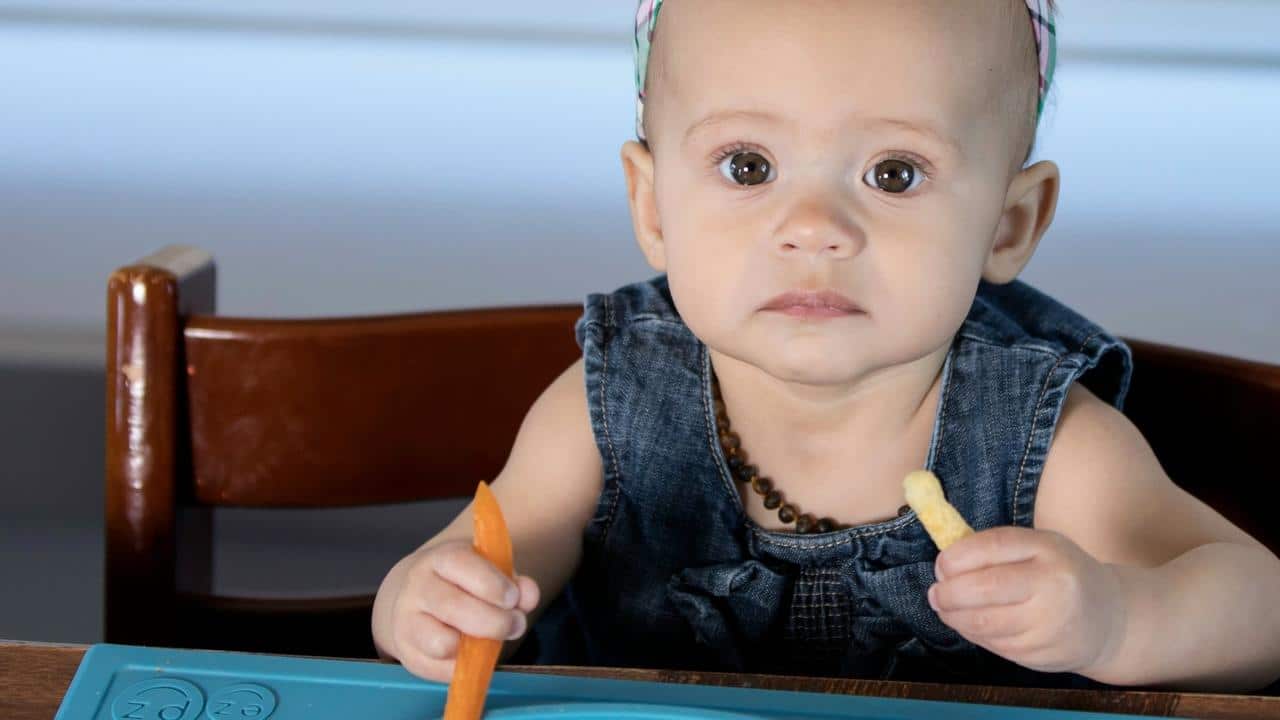
The 16 Best First Foods for Baby-led Weaning: A Dietitian’s Picks
Confused about what to feed your baby when starting solids? In this blog, our dietitian breaks down how Baby-led Weaning works and shares her favourite starter foods. This post contains some affiliate links.
Starting solids is a fun and exciting but confusing time. With many varying opinions about when, what, and how to feed your baby out there.
Baby-led weaning (BLW) is one popular method of introducing solid food to your baby. As a Registered Dietitian and author of “The Parent’s Guide to Baby-led Weaning” (affiliate link), a common question I get is, “What are the best starter foods for baby-led weaning?”
In this post, I’ll share my top 16 baby-led weaning first foods, including a sample starter Baby-led Weaning meal plan. But first, let’s cover some basics of BLW.
Benefits of Baby-led Weaning
- Baby-led Weaning is starting your baby on solids with finger food. You skip the spoon-feeding pureed food, and the baby feeds him or herself from the start! Here are some benefits of BLW:
- Self-feeding will help improve the baby’s finger dexterity and strength of mouth muscles. They may even talk earlier!
- Exposing your little one to many textures and tastes could prevent some picky eating later on. It creates more adventurous eaters!
- Your baby can listen to her appetite and learn how to self-regulate from the start. Responsive Feeding! There is no “here comes the airplane” or other pressure from mom or dad to eat more baby food.
- Baby–led feeding is cheap and easy! You can often feed your baby the same foods as you are eating; there is no need to buy baby food.
- Whole foods can be more nutritious than purees. If you make your own purees mixed with breastmilk or formula, that’s awesome. And store-bought purees are fine, too. But one of the main ingredients is water.
There are plenty of myths out there about Baby-led weaning, too. Check out four myths…..and the real truth by watching my free BLW webinar here.
When should I start baby-led weaning?
There are a few considerations when choosing when to start solids. I see most first-time parents super eager to start early. But honestly, it’s work, a mess, and you can’t go back. Enjoy your 100% milk-fed time!
Here are some signs of readiness to start solids:
Age: around six months of age, most babies are ready to start solids.
The recommendation to start solids at six months is from Health Canada, Centres for Disease Control and the World Health Organization. Most babies start running out of iron stores around six months, so they need iron-rich foods to continue optimal development.
Some doctors say four to six months. Either they’re still spouting old guidelines, OR they’re jumping to the conclusion that starting solids early is beneficial to prevent allergies for all babies. Neither of which is the current advice of any health organization I know of.
Your baby should have enough physical strength to self-feed.
Your baby needs the strength and motor skills to lean forward, grab food and get it to their mouth without needing arms for support. And lean forward to spit food out, if needed, for safety.
Your baby doesn’t need to sit unsupported for a certain number of minutes before starting solids. Total myth. As long as they can sit supported in their high chair. For more info on this, check out “When can I start solids with baby-led weaning.“
Your baby should also have some interest in eating.
Usually, around five months, babies become interested in putting everything in their mouths. Including toys and their hands. That’s actually preparing them to start solids and feed themselves.
Can you start baby-led weaning at five months or earlier? If your baby has the physical strength and interest, try at five months. Some babies are ready a bit early, and some a bit late. I wouldn’t recommend solids before five months, though.
And before you start solids, you can get your baby ready! Sit them at the table with you during meals. Give them something to chew on, like a plastic spoon or hard-munchable food. Baby will get practice moving that around in their mouth and decrease their gag reflex.
Can I do both Baby-led Weaning and purees?
Yes! Many people call this “combo” or “mixed” feeding. Technically, that’s not really “baby-led weaning”. But definitions aren’t important unless you’re participating in a research study. Many people call this “combo” or “mixed” feeding.
Combo feeding is actually what Health Canada recommends when starting solids. So you can start at six months with both purees and finger foods. And don’t worry about those who say your baby will get confused and choke. This is not proven by evidence.
It’s important to be truly “baby-led.” How does your baby prefer to eat?
Two most important factors when choosing BLW starter foods
There are two important considerations when choosing foods for your baby-led weaner: nutrient density (especially iron) and preventing choking.
High Iron Foods
A common practice I’ve seen is feeding babies exclusively fruits and vegetables when starting out. And while fruits and veggies contain vitamins, they are too low in energy and iron to be the sole offering.
Your baby needs lots of iron for mental and physical development. It’s the most important nutrient they get from food at this age.
Here are five tips to make sure your baby gets enough iron while using Baby-led Weaning:
- Offer a source of iron at each meal (two times per day when starting): scrambled eggs, black beans, tofu, cooked spinach, clams, oysters, liver, fish, beef, bison (higher in iron than beef!), chicken (dark meat is higher in iron than white) or pork.
- Offer fortified powder infant cereal baked into finger foods. You can substitute half of the flour in your pancake recipes for fortified infant cereal. Or offer your baby a “dipper spoon” (affiliate link) or pre-loaded spoon to self-feed the cereal.
- Include a source of vitamin C in the meal to increase absorption—basically a fruit or veggie. You can top fortified pancakes or cereal with fruit compote, serve lentils in stewed tomatoes and add spinach to a fruit smoothie.
- Cook with a cast iron pan or a Lucky Iron fish (affiliate link) to add a bit of extra iron to your foods.
- Use pureed meat as a spread or dip on toast or crackers (sort of like pate!).
Read this post for more information on how to get enough iron when using Baby-led Weaning.
Safe foods to prevent choking
Choking is the main thing parents worry about when offering finger foods. While baby-led weaners have not been shown to be more likely to choke, we want to prevent choking no matter how you start solids.
There are two main considerations in preventing choking. The texture and the size of foods you offer your baby.
Soft foods are also safer than hard foods. If they get past your baby’s gag reflex and baby chokes, soft foods are likely to be coughed back up easily.
The size of the food is also important. Avoid round food that could block your baby’s windpipe.
My favourite shape is large enough for a beginning baby to grasp with their palm but thinner than their windpipe. Think potato chip shape! Mandolins are great tools for this and work for apples, carrots, beets, and sweet potatoes. Then, you can steam the produce until it’s soft.
Spiralized foods are also fun! And you can use a cheese grater on hard, raw foods like apples and carrots once your baby has a pincer grasp.
BTW- babies can eat solid foods without teeth! You’ll know their gums are plenty strong if you’re breastfeeding and have ever been bitten. But don’t expect them to chew through a steak.
Tips to Prevent Choking with Baby-led Weaning
I have a full blog about the research on baby-led weaning and choking, the difference between gagging and choking and foods to avoid here: tips to prevent choking with BLW. Here are some quick tips:
- Let baby self-feed. Never put a piece of food into your baby’s mouth. It may immediately fall to the back without the baby having a chance to control it with their tongue and chew.
- Always watch your baby while they eat. Choking is silent. And sitting down to eat with your baby is one of the benefits of Baby-led Weaning!
- Offer soft food. If food does happen to get past the gag reflex and cause your baby to choke, they will be more likely to cough up soft food. Test the foods to make sure you can mash them with your tongue on the roof of your mouth.
- Offer safe sizes of food. Baby’s air tube is about the width of a straw. So avoid round items, which could totally block the air tube. Slice foods thinly, if possible.
- No distractions during meals. Don’t have toys to play with or the TV during meals, as a distracted baby is likelier to choke. You might have to lock the dog up during meals!
- High Chair position. If a baby is leaning to one side or too low, roll up towels to support them. And their feet should sit on a footrest for better stability. I prefer not to buckle the high chair (unless there’s a risk of your baby falling or climbing out). That way, you can get them out quickly if needed.
Top 16 Baby-led Weaning first foods
Need some baby-led weaning food ideas? Here are my top choices for starter foods for baby. These foods provide a variety of important nutrients your baby needs to grow, like iron, Vitamin C and fat.
Avocado
Ripe avocado slices are a great starter food for BLW, as avocados are soft and high in healthy fats.
However, it can be hard to grasp slippery foods! Cut thin slices of avocado and roll them in infant cereal, ground flax or ground nuts. This adds extra nutrition and makes it easier to grasp the avocado
Sweet Potato
Sweet potatoes contain plenty of Vitamin C and fibre. You can cut them into fry shapes and bake them. Or make sweet potato chips! A mandolin is perfect for this. Brush with oil and bake steam until soft.
Chicken
The heme iron in dark chicken meat is easier to absorb than the white breast meat. Cook the meat in a slow cooker or pressure cooker. You can shred the thighs or offer your baby a whole leg (gristle and skin removed) to gnaw on!
Carrots
Carrots can be sliced into thin, long strips and steamed. And once your baby can pick up smaller pieces, you can serve raw grated carrots, like this baby is eating!
Muffins
Muffins are easy to grasp and eat for little ones and are great for on-the-go snacks for toddlers too. These Avocado Blueberry Mini-Muffins have some flour substituted for infant cereal to boost the iron.
Cheese
My favourite cheese for a baby is Bocconcini. It’s soft mozzarella balls. With little to no added sodium! Paneer is a great choice as well.
Other cheese is ok, but remember to keep your baby’s sodium intake down. While North America has no upper limit for sodium recommendations, the UK recommends sticking to under 1000mg sodium for six to 12-month-olds.
Eggs
Eggs are high in protein and some difficult-to-find nutrients like choline. The yolks are also a source of iron. And yes, you can offer egg yolks and whites (and all other common allergens) after six months!
I like to serve fried eggs sliced into long strips for beginner babies. And scrambled once your baby has a pincer grasp and can pick up the pieces.
You can also scramble eggs with added chopped fried or steamed veggies and grated cheese and bake them into egg muffins.
Beans
Beans are a good source of protein, fibre and iron. Until your baby has a pincer grasp and can pick beans up, mash them onto toast strips.
Or offer beans as a dip, like hummus. Your baby can use their hands (if you’re brave!), a “dipper” spoon (like a Num Num Pre-Spoon-GOOtensil –affiliate link) or food like a breadstick to dip into the mashed beans.
When your baby works on their pincer grasp, rinse canned black beans and pop them onto their tray. Split chickpeas in half, and mush larger beans like kidney beans.
Ribs
When your baby is starting out, they will need larger strips of food to hold in their palm. They will eat the food down to their palm, let go of the portion “caught” in their fist and move on to the next piece.
Ribs are a perfect size and, when cooked in a pressure cooker or slow cooker, will be very tender for your baby. Plus, they are high in iron and make a great photo op!
Meatballs
Ground meat is an easy way to offer your baby heme iron. The iron in meat is the best-absorbed source and is called heme iron.
Meatloaf or meatballs are a great way to serve ground bison, beef, chicken or turkey. Press the metaballs down before baking, and you’ll have baby burgers!
Bison is super high in iron. Check out this post to read why I love bison as a starter food and for a meatball recipe.
Fish
Fish contains the omega-3 fat DHA and is a source of iron, too. Once your baby can pick it up, you can offer canned, no-sodium-added salmon right out of the can! How easy is that?!
You can also make fish cakes like these Tasty Fish Cakes!
Another way to serve fish once your baby has a pincer grasp is just shred it and place it on their tray, like this baby! Or canned low-sodium salmon is fine too.
Yogurt
Yes, babies can have dairy at six months! We now know introducing higher-risk allergens like dairy sooner can promote tolerance.
For yogurt, look for a high milk fat percentage – you can find 3% to 10%. With no added sugar, sweeteners or colours. Just plain. If your baby refuses plain yogurt multiple times, you can mix in a fruit puree for flavour.
Peanut butter
How do you serve peanuts to your baby? Take a slice of soft whole wheat bread, slice the crust, and cut it into strips. Spread a thin layer of natural peanut butter on the toast finger and offer it to your baby.
To help promote tolerance and prevent food allergies, it’s now recommended to introduce peanuts to your baby around six months of age.
Toast
The easiest way to serve bread is lightly toasted and cut into strips. Find a lower-sodium bread that’s whole grain but doesn’t have chunks of nuts or seeds. Slice off the crust, and toast until it’s no longer gummy but not too hard and crunchy.
And don’t serve the toast plain. The same goes for crackers, like Baby Mum Mums. Add toppings like mashed beans, avocado, cheese, or nut butter for more nutrition.
Check out my Instagram reel cracker/toast toppings ideas for added energy, iron-rich toppings, and constipation cures.
Waffles
Waffles are a great baby-led weaning breakfast idea. Just like with muffins, you can substitute half of any flour in a recipe with fortified infant cereal. Choose a basic waffle recipe with no added sugar.
Slice the waffle into strips and add a topping like peanut butter. Or allow your baby to “dip” it into plain yogurt or a fruit puree.
Apples
Full apples are the #1 food Baby-led Weaners choke on. Instead, peel and slice the apples thinly and steam the apples until tender.
Once your baby is older, you can grate a full, raw apple with a cheese grater.
Combining these first foods for Baby-led Weaning first foods into meals
Do you just offer your baby one of these foods to start? I prefer to offer small amounts of two or three foods per baby’s meal twice daily at six months. Add in a third meal around nine months and snacks at twelve months.
If you offer your baby a combo of these foods, they will get a balanced diet:
Talking spices for a baby on Global
1) A high-iron food: fortified muffins or pancakes (with infant cereal added), eggs, meat, fish, and beans.
2) Food high in vitamin C: fruit or vegetable like berries, squash or broccoli.
3) High-calorie food: nut butter, cheese, butter, avocado, full-fat yogurt.
You can also offer your baby spices like oregano, cinnamon, curry and garlic powder! It may even prevent picky eating as I discussed on Global news.
Baby-led Weaning sample meal plan
Below is a sample baby-led weaning meal plan for starting solids with your baby to help you put this together. Note that each meal includes a source of iron, vitamin C and fat.
*Recipes are from my baby-led weaning book “The Parents Guide to Baby-led Weaning” (affiliate link).
And, of course, one of the benefits of baby-led weaning is being able to eat the family foods together. Here are some more tips on how to modify family meals.
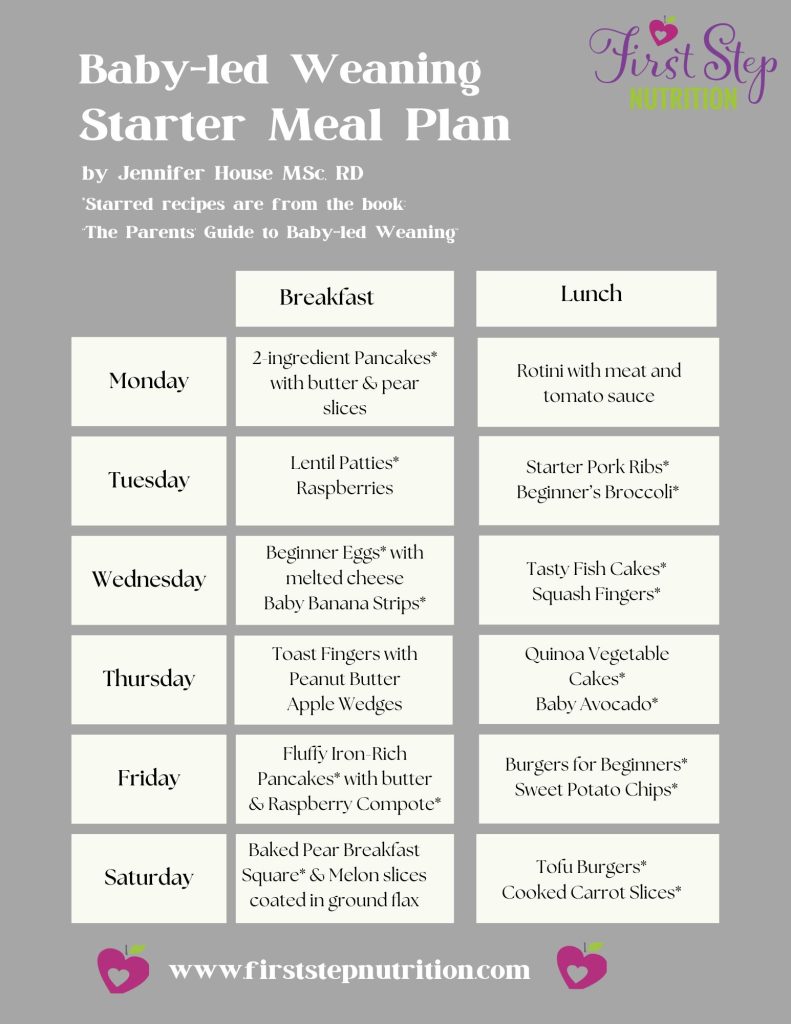
Baby-led Weaning Foods to Avoid
While you no longer have to avoid allergenic foods during the first year, there are a few foods you will want to avoid for your baby. These include:
- Honey: Avoid until 12 months due to botulism risk.
- Highly sweetened foods: No matter the type of sugar (including maple syrup, agave nectar, etc), it’s low in nutrients.
- Salty foods: Your baby’s kidneys are not ready to process a lot of sodium. If you’re preparing food at home, leave the salt out and add it to the adult portions after serving your baby. Or if pre-prepared, rinse the baby’s portion in a strainer.
- Low-fat foods: Items in this category, such as fat-free yogurt or light cheese, aren’t a good choice for little ones. Babies need lots of fat for brain development and growth.
- Raw fish, meat or raw milk: Your baby is more prone to foodborne illness, so best not to risk it.
- Artificial sweeteners and colourings: Sweeteners provide no nutritional value, and artificial colourings have been linked to behaviour issues in children.
When can my baby have water and milk?
You can offer your baby a small amount (1-2 oz) of water with meals. While they don’t need a lot of extra fluid at this age, it can help prevent constipation. And strengthen oral motor muscles if you offer an open cup.
As for full-fat milk as a drink – wait until closer to 12 months for milk to be your baby’s main fluid source. It doesn’t have the iron or nutrients that breast milk or formula does. Full-fat goat’s milk can work instead of cow’s milk if you prefer.
Avoid milk alternatives like hemp, rice, coconut, etc, until two years of age. They just don’t have the fat and protein that human milk, formula or whole cow’s milk have for this short time period of fast growth
What about the mess?
Another concern about offering your baby table foods and self-feeding is: what about the mess?! Yes- starting solids is messy no matter how you do it!
Feed your baby without a shirt 🙂 I purchased an office computer chair mat to place under my babies’ high chairs for easier clean-up. Also, “food catchers” (affiliate link) attach to the high chair so less food hits the floor.
And if your baby has reached a food-throwing stage – it’s frustrating, but know that it is just a phase! I have a full blog on tips to manage food throwing here.
Conclusion
That was a lot of information to take in. If you want more tips, sign up for my free webinar: Benefits & Myths of Baby-led Weaning.
Hopefully, I’ve cleared up some confusion about when and how to use Baby-led Weaning. Remember, starting solids doesn’t have to be stressful or overwhelming. It should be fun. Cheers!
Founder of First Step Nutrition | Registered Dietitian Nutritionist
Jen believes raising happy, well-nourished eaters who have a healthy relationship with food doesn't have to be a battle! She is an author and speaker with 18 years of experience specializing in family nutrition and helps parents teach their kids to try new foods without yelling, tricking, or bribing.
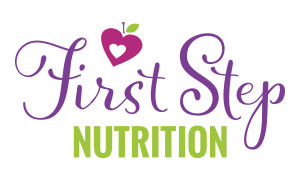




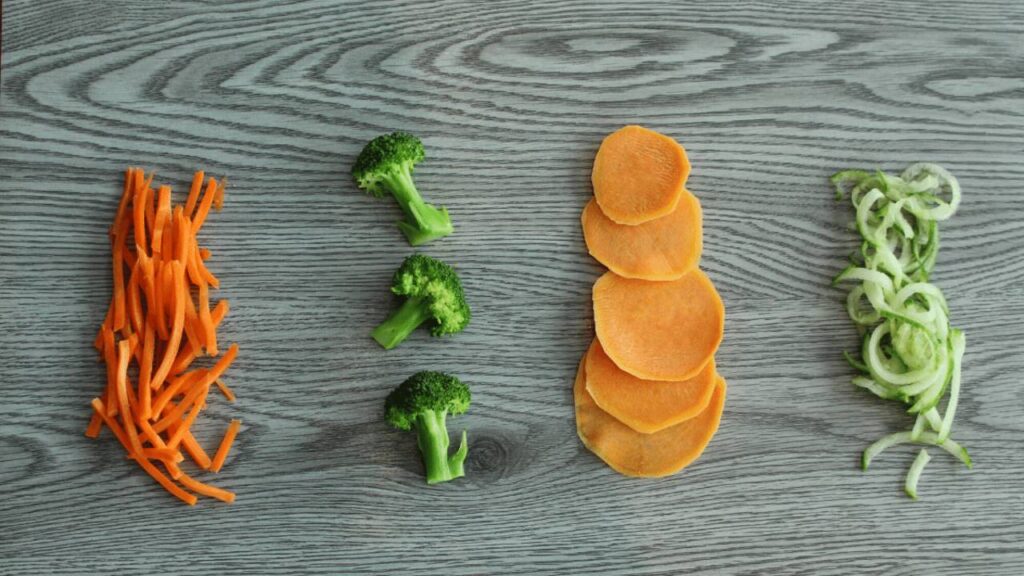
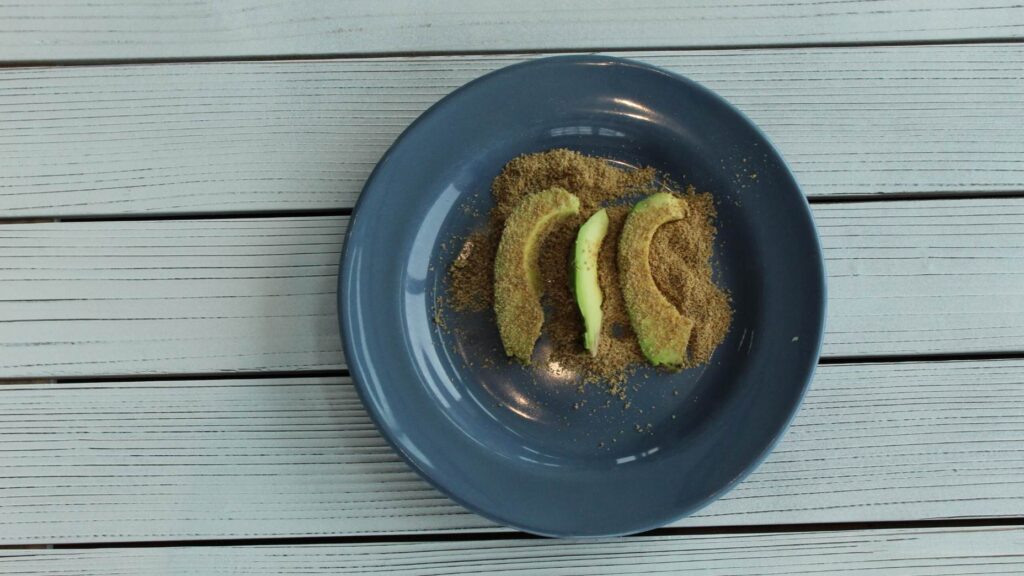
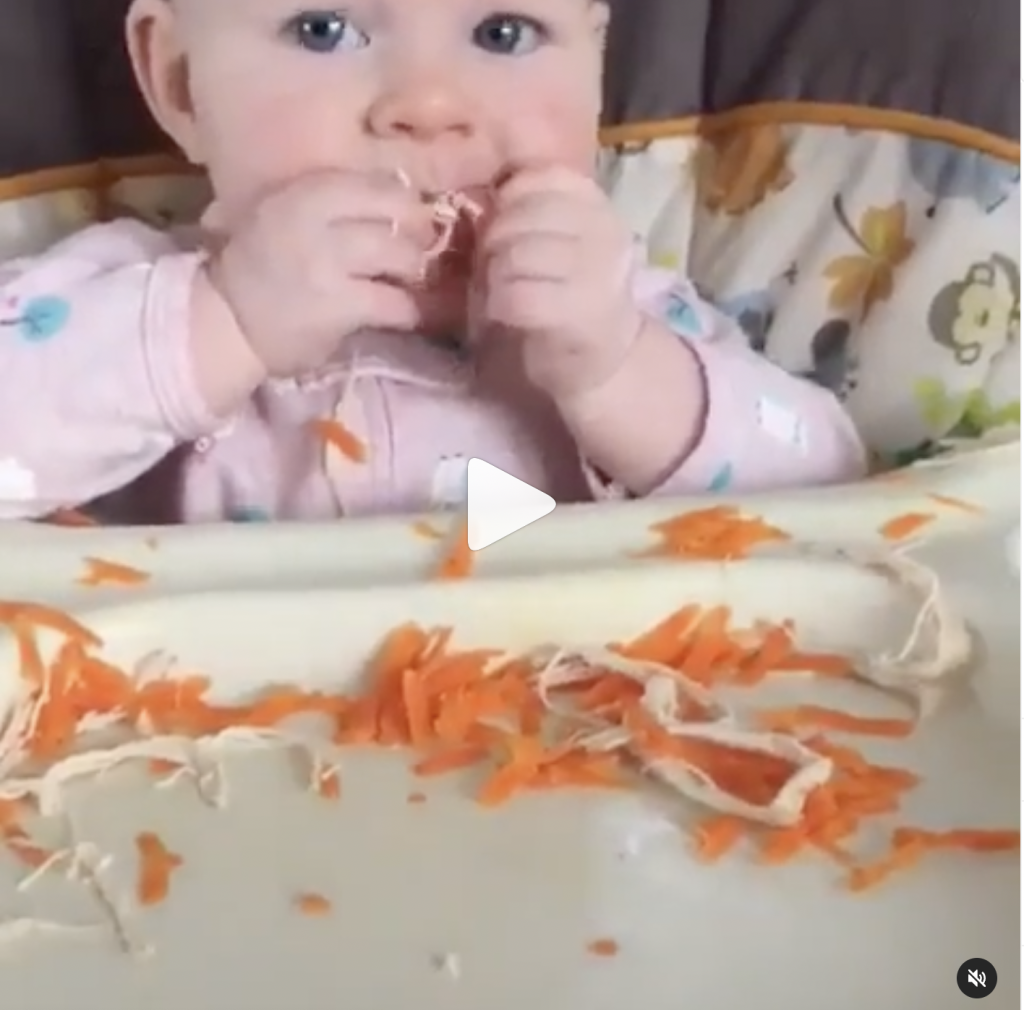
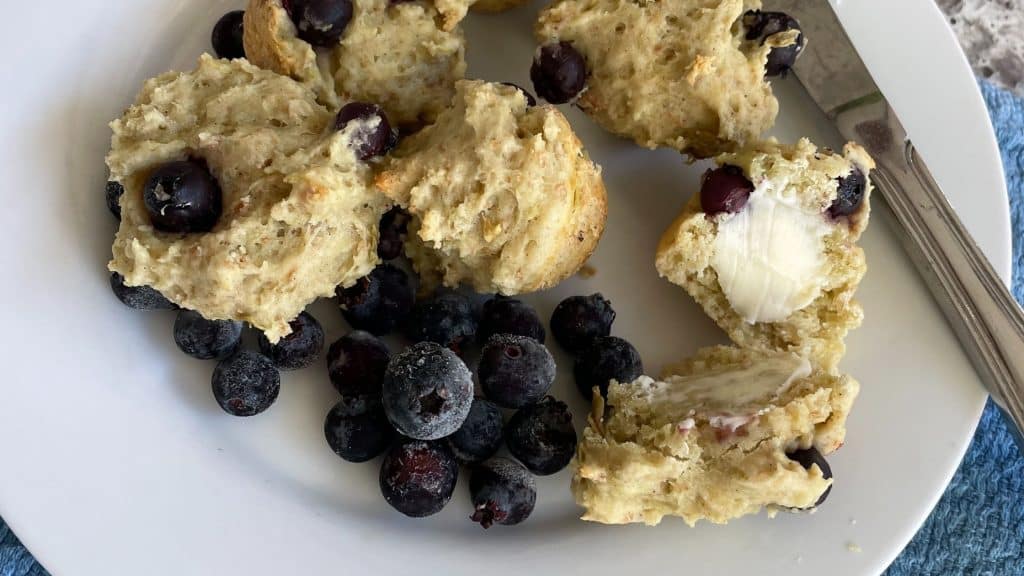
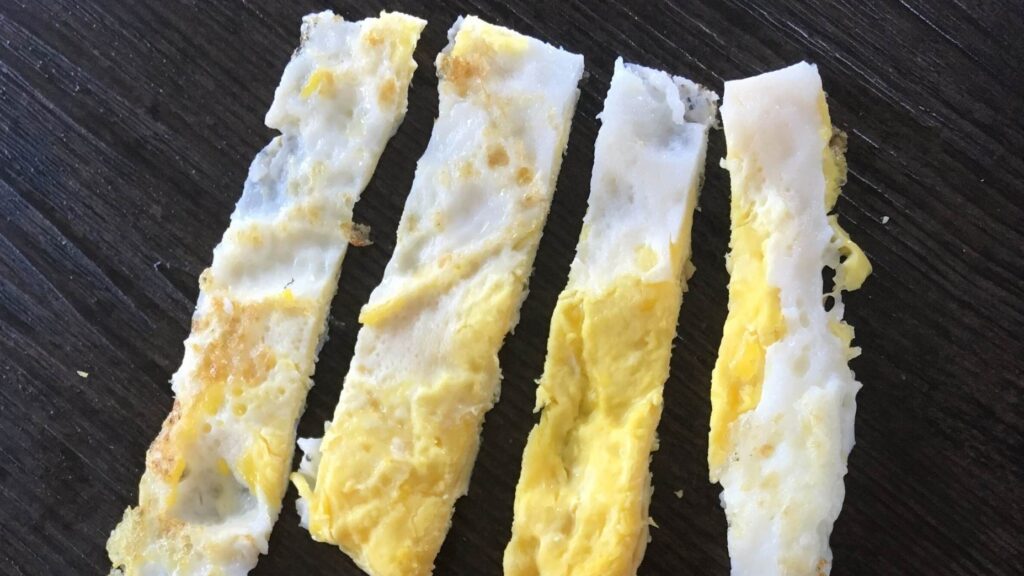
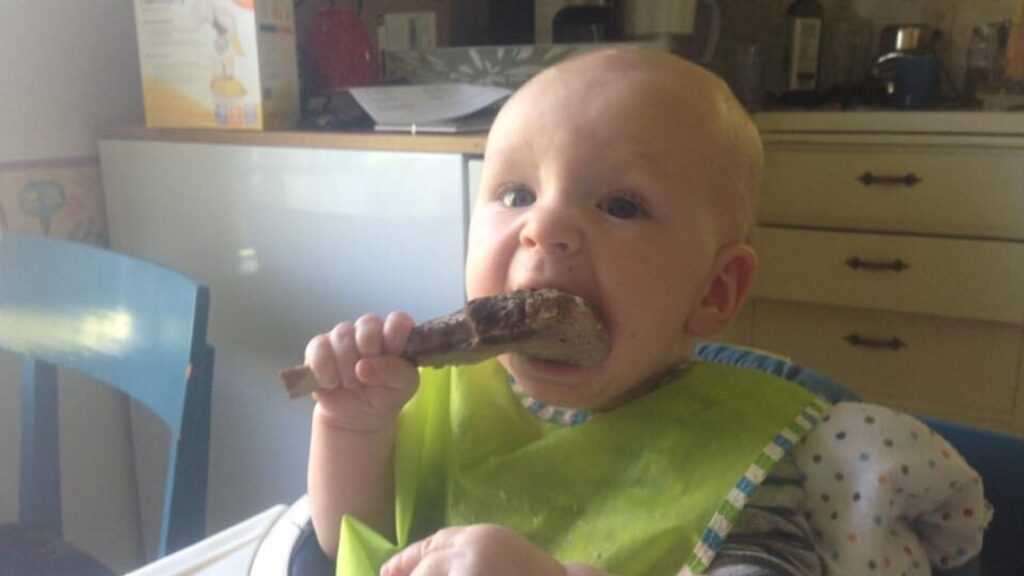
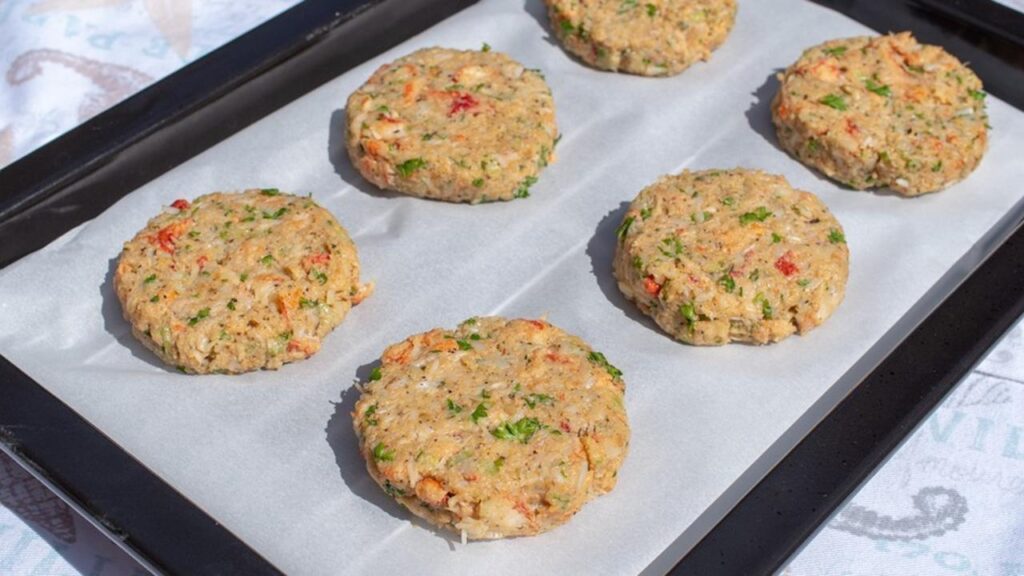
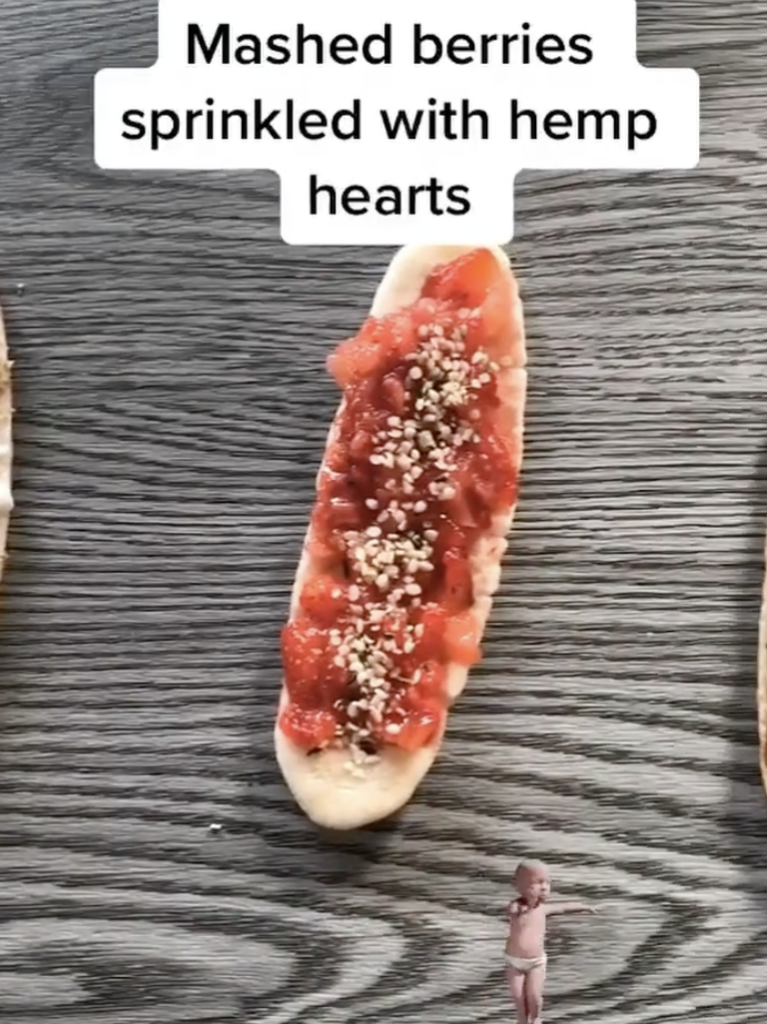
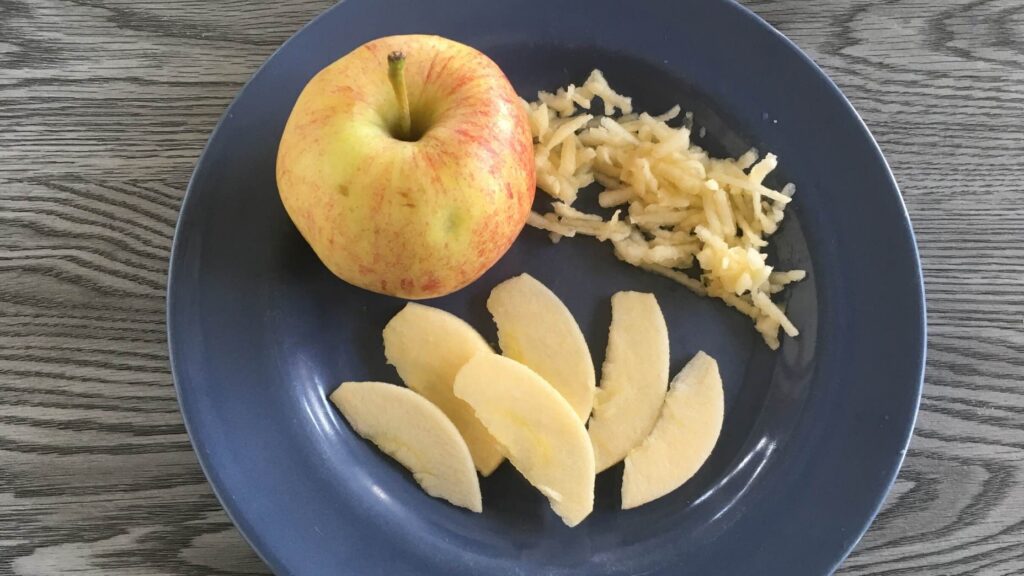

No Comments